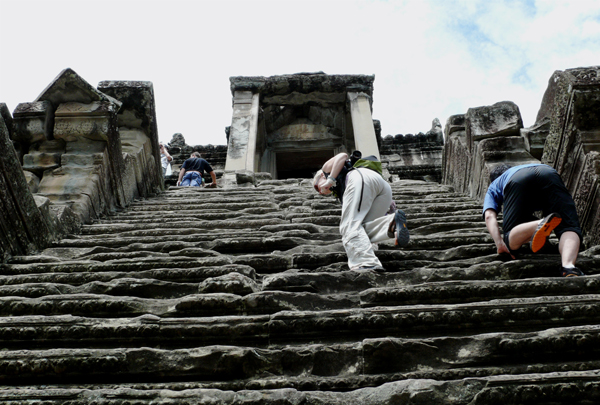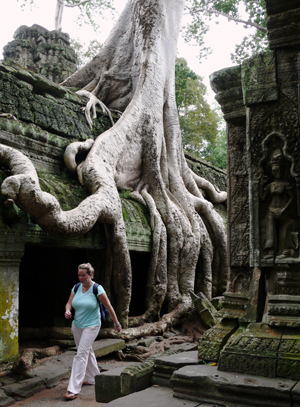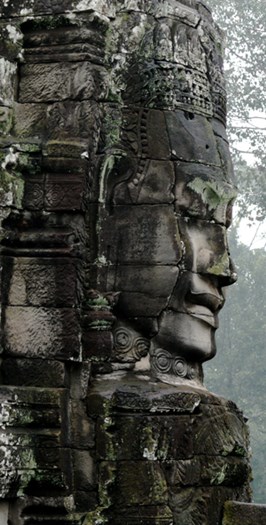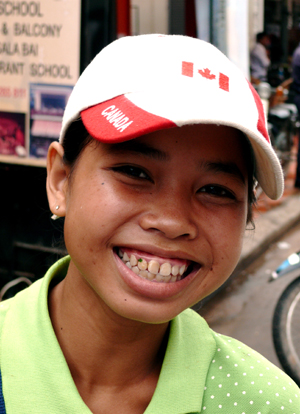SIEM REAP, CAMBODIA - Mr. Happy is not happy. The delightful guide with the infectious laugh whose real name “Soc” means “happy” in Cambodian, has lost sight of members of the tour group he’s guiding through the tangled roots and crumbled temples of Ta Prohm, one of the major archeological sites at Angkor Wat. “Where can they be?” wonders Soc, who likes to be called “Mr. Happy.”
As we wait for the stragglers to catch up, Mr. Happy entertains us with tales about life back in the 12th century, the time when the massive Angkor Wat complex was completed to serve the Khmer ruler of the day, King Suryavaram II.
The buildings and temples that make up Angkor Wat are prime examples of the classical Khmer style of architecture used between the 11th and 12th centuries – a time when Khmer architects became so confident in their skills that they abandoned traditional building techniques and materials like brick and began using sandstone blocks, which allowed them to create the detailed temple facades that tourists now marvel.
The results of the ancient builders’ efforts are truly spectacular and now almost a million people come to remote Siem Reap each year to witness the grandeur of Angkor Wat - and the UNESCO World Heritage Site never disappoints.
Tourism is the main industry in this desperately poor region of one of Asia’s most economically depressed countries, and Soc tells us tourists are not just good for the economy but also good for Angkor Wat, because 20 per cent of their $20 one-day admission fee goes to maintain and repair the magnificent site.
Of all the beautiful temples that make up Angkor Wat, though, romantic Ta Prohm is the favourite among visitors, according to Soc. And it’s not hard to see why.

Above: Climbing to the top of the temples on steep stairs.
Ta Prohm has been left pretty much as French explorers found it in the late 19th century, save for some repair work that keeps the fragile site from decaying further.
Most of the temples at Ta Prohm remain encased in the clutches of serpentine banyan tree roots that overtook it during a natural reclamation process that saw the surrounding tropical rain forest crawl over the site after it was abandoned centuries ago. The banyan tree roots are so strong; they were able to pry apart the giant sandstone blocks used to construct the impressive temples. Suddenly, a smile returns to Soc’s face as the tour group is reunited - Mr. Happy is happy again.
As we move onto another of Angkor Wat’s great attractions, Bayon, the last state temple to be built at Angkor, Soc tells us that at its peak more than a million people lived within the city walls.
“Angkor was more populated than London at that time,” says Soc as we reach the entrance of Bayon Temple, built to honour Buddhist King Jayavarman VII.
Bayon, which stands at the centre of King Jayavarman’s former capital, features a multitude of serene and massive stone faces that tower over visitors, who just can’t stop snapping pictures of the chiseled likenesses.
Another impressive feature we find at Bayon is two sets of bas-reliefs, which present an unusual combination of mythological, historical and mundane scenes.
The whole Bayon site is overwhelming and prying the group away begins to frustrate Soc, who is trying to keep to our rigged tour schedule.
“Please,” says an unhappy Mr. Happy, “we must stay to the schedule if we are to see all the sites – remember, you are here for only one day.”
As we move onto the main Ankgor Wat ruins, Soc tells us more than 100 temples make up the site, which was sacked by an invading Thai army in 1431 and abandoned the following year. Wandering Buddhist monks passing through the dense jungle would come upon the site in the years that followed and myths and fables quickly spread about what they dubbed sacred ground.



Above: Tourists visit the stone monuments while locals flash smiles.
European explorers who heard about the site attempted to locate what became known as “the strange city lost in the jungle” but to no avail. Finally, in 1860, French explorer Henri Mouhot discovered the ruins and a restoration project, which continues today, began. The main temple at Angkor Wat is indeed a fitting home for the kings who lived here and who ruled over a vast empire that stretched from Vietnam and China to the Bay of Bengal.
Theories abound about the architectural makeup of the main temple complex – some scholars believing it was built in the shape of a fort because this was a strategic military position during Khmer times; but others argue the arrangement of the temples mirrors the stars in the constellation Draco at the time of the spring equinox.
No matter the theories, the main temple is out of this world.
Soon Mr. Happy is leading the group up steep stone steps to the highest point of the main temple and the view of the entire site – best viewed at sunrise or sunset – is breathtaking.
This is Cambodia’s Pyramids; its Great Wall – one of the most remarkable engineering achievements ever attempted and completed. As most members of the tour group scurry off to collect more photographs, I sit with Soc and ask about his life in Siem Reap. “It is good now,” says Mr. Happy, who says he and so many other Cambodians are still trying to recover from the brutal rule of Pol Pot and his Khmer Rouge thugs, who terrorized the gentle people of this country throughout the 1970s. (Many are just now standing trial for their crimes against humanity).
Just about every family in Cambodia, where most people still live in abstract poverty, were touched by the despot actions of the Khmer Rouge – especially Soc.
“My father was taken from our home by Pol Pot’s army and the children were separated from my mother. We were sent to camps where I was tortured,” says Soc.
“But my father was taken to the Killing Fields (rice paddies just outside Siem Reap where thousands of Cambodians were murdered and their bodies left to decay in the oppressive heat that always hangs over this city).”
Soc tells me he is still haunted by the night the soldiers came for his father.
“I was just a little boy but I can still hear the Khmer Rouge commander ordering my father over a loud speaker to show himself or he would blow up our home,” says Soc.
“My father opened the door and pleaded with the officer to let the family go free – ‘I am the one you want, not them,’ he told them, and then he came back into the house and told my mother to gather the children and escape through the back door.
“He smiled at me and that was the last time I ever saw my father,” says Soc through sad eyes.
As the tour group gathers again, a smile returns to Mr. Happy’s face and he says he has a surprise to end our visit to Siem Reap. “I take you to the Red Piano Bar in town and I buy you a drink because you are now my friends,” says Mr. Happy.
A short time later, while enjoying a cold beer in a bar where Angelina Joli “hung out” while making her breakthrough movie Tomb Raiders, Mr. Happy points to a chair that the actor reportedly sat on during her visits and which now occupies a place of honour above the bar, and says: “she (Joli) liked Cambodians so much she took one of us home with her.”
Mr. Happy was referring to Joli’s decision to adopt an orphaned Cambodian child, a boy she named Murdoch.
“If she wanted a boy, she could have adopted me,” says Mr. Happy as the group breaks into laughter.
The fact that Mr. Happy can still smile after all that has happened to he and his family is a tribute to the resolve of the Cambodian people.This historic place will forever be haunted by the tragic consequences of the Khmer Rouge’s brutal actions but at least the tourists who come here find joy now – thanks to Mr. Happy.